| Revision as of 11:19, 18 September 2010 editXanderliptak (talk | contribs)3,323 edits →Irish Coat of Arms← Previous edit | Revision as of 07:37, 26 September 2010 edit undoRich Farmbrough (talk | contribs)Edit filter managers, Autopatrolled, Extended confirmed users, File movers, Pending changes reviewers, Rollbackers, Template editors1,725,965 editsm replace markup with template and general fixes. using AWBNext edit → | ||
| Line 1: | Line 1: | ||
| ] | ] | ||
| '''Irish heraldry''' are the forms of ], such as ]s, in the ]. It is regulated by the ]. | '''Irish heraldry''' are the forms of ], such as ]s, in the ]. It is regulated by the ]. | ||
| ==Terminology== | ==Terminology== | ||
| In English, achievements of arms are usually described ('']ed'') in a specialized jargon that uses derivatives of ] terms. In Irish, however, achievements of arms are described in language which, while formal and different from plain language, is not quite so opaque as Anglo-Norman terminology is in English. Nevertheless Irish heraldic terminology is a kind of specialized jargon. Examples include the use of Irish ''gorm'' and ''uaine'' for blue and green, as compared to the French-derived ''azure'' and ''vert'' used in English blazon.<ref> | In English, achievements of arms are usually described ('']ed'') in a specialized jargon that uses derivatives of ] terms. In Irish, however, achievements of arms are described in language which, while formal and different from plain language, is not quite so opaque as Anglo-Norman terminology is in English. Nevertheless Irish heraldic terminology is a kind of specialized jargon. Examples include the use of Irish ''gorm'' and ''uaine'' for blue and green, as compared to the French-derived ''azure'' and ''vert'' used in English blazon.<ref> | ||
| {{ |
{{Cite book | ||
| | last = Williams | | last = Williams | ||
| | first = Nicholas | | first = Nicholas | ||
| | authorlink = |
| authorlink = | ||
| | coauthors = |
| coauthors = | ||
| | title = Armas: Sracfhéachaint ar Araltas na hÉireann | | title = Armas: Sracfhéachaint ar Araltas na hÉireann | ||
| | publisher = Coiscéim | | publisher = Coiscéim | ||
| Line 15: | Line 16: | ||
| | location = Baile Átha Cliath | | location = Baile Átha Cliath | ||
| | pages = vii, 224, 39 Plates | | pages = vii, 224, 39 Plates | ||
| | url = |
| url = | ||
| | doi = |
| doi = | ||
| | id = |
| id = | ||
| | isbn = }}</ref> |
| isbn = }}</ref> | ||
| <center> | <center> | ||
| Line 63: | Line 64: | ||
| {| class="wikitable" cellpadding="2" | {| class="wikitable" cellpadding="2" | ||
| !]<br> |
!]<br> | ||
| Ríphíosaí | Ríphíosaí | ||
| | align="center" |] | | align="center" |] | ||
| Line 88: | Line 89: | ||
| | align="center" |Rachtán | | align="center" |Rachtán | ||
| |- | |- | ||
| !Ordinaries<br> |
!Ordinaries<br> | ||
| Ríphíosaí | Ríphíosaí | ||
| | align="center" |] | | align="center" |] | ||
| Line 137: | Line 138: | ||
| {| class="wikitable" border="1" cellpadding="2" | {| class="wikitable" border="1" cellpadding="2" | ||
| !] | !] | ||
| | align=center |] | | align=center |] | ||
| | align=center |] | | align=center |] | ||
| Line 171: | Line 172: | ||
| ==Office of the Chief Herald of Ireland== | ==Office of the Chief Herald of Ireland== | ||
| {{ |
{{Main|Office of the Chief Herald of Ireland}} | ||
| The Office of the Chief Herald of Ireland, sometimes incorrectly called the Office of Arms, is the Republic of Ireland's authority on all ] matters relating to ] and is located at the ]. The office was constituted on 1 April 1943, taking over the records of the ], a ] office dating from 1552. | The Office of the Chief Herald of Ireland, sometimes incorrectly called the Office of Arms, is the Republic of Ireland's authority on all ] matters relating to ] and is located at the ]. The office was constituted on 1 April 1943, taking over the records of the ], a ] office dating from 1552. | ||
| Line 179: | Line 180: | ||
| *Persons living abroad who are of provable Irish descent in either the paternal or maternal line | *Persons living abroad who are of provable Irish descent in either the paternal or maternal line | ||
| *Persons with significant links to Ireland | *Persons with significant links to Ireland | ||
| *Corporate bodies within Ireland and corporate bodies with significant links to Ireland but based in countries with no heraldic authority. |
*Corporate bodies within Ireland and corporate bodies with significant links to Ireland but based in countries with no heraldic authority. | ||
| ==Irish Coat of Arms== | ==Irish Coat of Arms== | ||
| {{double image|right|Coat of arms of Ireland.svg|150|Crest of ireland.png|150|The escutcheon (left) and crest (right) used by the British monarchs to represent their dominion over Ireland. In 1945, the newly independent ] adopted the same shield, ''Azure a harp Or stringed argent'', to represent their state.}} | {{double image|right|Coat of arms of Ireland.svg|150|Crest of ireland.png|150|The escutcheon (left) and crest (right) used by the British monarchs to represent their dominion over Ireland. In 1945, the newly independent ] adopted the same shield, ''Azure a harp Or stringed argent'', to represent their state.}} | ||
| {{ |
{{Main|Coat of arms of Ireland}} | ||
| The Coat of arms of Ireland is ]ed as ''Azure a harp Or, stringed argent'' - a gold ] with silver strings on a ] background. The harp, and specifically the ] (or Gaelic harp), has long been ]'s heraldic emblem. It appears on the ] which were officially registered as the arms of the state of ] on 9 November 1945. The harp has been recognised as a ] of ] since the 13th century<ref></ref> | The Coat of arms of Ireland is ]ed as ''Azure a harp Or, stringed argent'' - a gold ] with silver strings on a ] background. The harp, and specifically the ] (or Gaelic harp), has long been ]'s heraldic emblem. It appears on the ] which were officially registered as the arms of the state of ] on 9 November 1945. The harp has been recognised as a ] of ] since the 13th century<ref></ref> | ||
| {{Clear}} | |||
| <br clear="all"> | |||
| ==References== | ==References== | ||
| Line 192: | Line 193: | ||
| {{Heraldry by country}} | {{Heraldry by country}} | ||
| {{Use dmy dates|date=September 2010}} | |||
| {{DEFAULTSORT:Irish Heraldry}} | |||
| ] | ] | ||
| {{ |
{{Heraldry-stub}} | ||
| {{Ireland-stub}} | {{Ireland-stub}} | ||
Revision as of 07:37, 26 September 2010
Irish heraldry are the forms of heraldry, such as coats of arms, in the Republic of Ireland. It is regulated by the Office of the Chief Herald of Ireland.
Terminology
In English, achievements of arms are usually described (blazoned) in a specialized jargon that uses derivatives of French terms. In Irish, however, achievements of arms are described in language which, while formal and different from plain language, is not quite so opaque as Anglo-Norman terminology is in English. Nevertheless Irish heraldic terminology is a kind of specialized jargon. Examples include the use of Irish gorm and uaine for blue and green, as compared to the French-derived azure and vert used in English blazon.
| Tinctures | Metals | Paints or Colours | Furs | ||||||
|---|---|---|---|---|---|---|---|---|---|
| Escutcheons | 
|

|

|

|

|

|

|

|

|
| English | Or | Argent | Azure | Gules | Vert | Purpure | Sable | Ermine | Vair |
| Irish | Ór (órga) | Airgead (airgidí) | Gorm | Dearg | Uaine | Corcra | Dubh | Eirmín | Véir |
| Ordinaries Ríphíosaí |
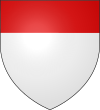
|
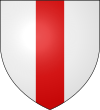
|
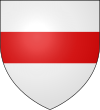
|

|

|

|
|---|---|---|---|---|---|---|
| English | Chief | Pale | Fess | Bend | Bend sinister | Chevron |
| Irish | Barr | Cuaille | Balc | Bandán | Clébhandán | Rachtán |
| Ordinaries Ríphíosaí |

|

|

|

|

|

|
| English | Cross | Saltire | Pall | Pall subverted | Pile | Bordure |
| Irish | Cros | Sailtír | Gabhal | Gabhal aisiompaithe | Ding | Imeallbhord |
| Division of the field | 
|

|

|
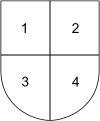
|

|
|---|---|---|---|---|---|
| English | Party per fess | Party per pale | Party per bend sinister | Quarterly | Quarterly charged with an inescutcheon |
| Irish | Gearrtha | Deighilte | Cléroinnte | Ceathair-roinnte | Ceathair-roinnte móide lársciath |
| Lines of division | 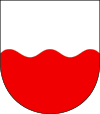
|
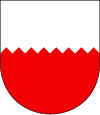
|
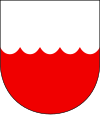
|

|
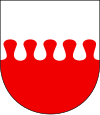
|
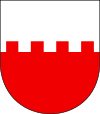
|

|

|
|---|---|---|---|---|---|---|---|---|
| English | Wavy | Indented | Engrailed | Invected | Nebuly | Embattled | Dovetailed | Potenty |
| Irish | Camógach | Eangach | Clasach | Dronnógach | Néállach | Táibhleach | Déadach | Cathógach |
Office of the Chief Herald of Ireland
Main article: Office of the Chief Herald of IrelandThe Office of the Chief Herald of Ireland, sometimes incorrectly called the Office of Arms, is the Republic of Ireland's authority on all heraldic matters relating to Ireland and is located at the National Library of Ireland. The office was constituted on 1 April 1943, taking over the records of the Ulster King of Arms, a crown office dating from 1552.
It has jurisdiction over:
- All Irish citizens, male or female
- Persons normally resident in Ireland
- Persons living abroad who are of provable Irish descent in either the paternal or maternal line
- Persons with significant links to Ireland
- Corporate bodies within Ireland and corporate bodies with significant links to Ireland but based in countries with no heraldic authority.
Irish Coat of Arms
Main article: Coat of arms of IrelandThe Coat of arms of Ireland is blazoned as Azure a harp Or, stringed argent - a gold harp with silver strings on a St. Patrick's Blue background. The harp, and specifically the Clársach (or Gaelic harp), has long been Ireland's heraldic emblem. It appears on the coat of arms which were officially registered as the arms of the state of Ireland on 9 November 1945. The harp has been recognised as a symbol of Ireland since the 13th century
References
-
Williams, Nicholas (2001). Armas: Sracfhéachaint ar Araltas na hÉireann. Baile Átha Cliath: Coiscéim. pp. vii, 224, 39 Plates.
{{cite book}}: Cite has empty unknown parameter:|coauthors=(help) - Civic Heraldry of Ireland, National arms of Ireland, Ralf Hartemink, 1996
| Heraldic traditions by country | |
|---|---|
| Africa | |
| Americas | |
| Asia | |
| Europe | |
| Oceania | |
This heraldry-related article is a stub. You can help Misplaced Pages by expanding it. |
This Ireland-related article is a stub. You can help Misplaced Pages by expanding it. |